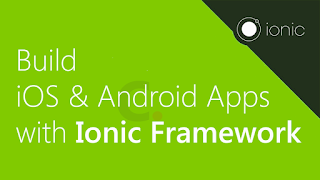Ionic is open source framework used for developing mobile applications. It provides tools and services for building Mobile UI with native look and feel. Ionic framework needs native wrapper to be able to run on mobile devices. This is an introductory tutorial, which covers the basics of the Ionic Open Source Framework and explains how to deal with its various components and sub-components. Ionic Framework is built on top of AngularJS and Apache Cordova, you will need to have basic knowledge about these technologies and need to be familiar with HTML, CSS and JavaScript.
Ionic is an HTML5 Mobile App Development Framework targeted at building hybrid mobile apps. Think of Ionic as the front-end UI framework that handles all the look and feel and UI interactions your app needs to be compelling. Kind of like "Bootstrap for Native", but with the support for a broad range of common native mobile components, slick animations and a beautiful design.
Ionic Framework Features

AngularJS − Ionic is using AngularJS MVC architecture for building rich single page applications optimized for mobile devices.
CSS components − With the native look and feel, these components offer almost all elements that a mobile application needs. The components’ default styling can be easily overridden to accommodate your own designs.
JavaScript components − These components are extending CSS components with JavaScript functionalities to cover all mobile elements that cannot be done only with HTML and CSS.
Cordova Plugins − Apache Cordova plugins offer API needed for using native device functions with JavaScript code.
Ionic CLI − This is NodeJS utility powered with commands for starting, building, running and emulating Ionic applications.
Ionic View − Very useful platform for uploading, sharing and testing your application on native devices.
Licence − Ionic is released under MIT license.
Ionic Framework Advantages
Ionic is used for Hybrid App Development. This means that you can package your applications for IOS, Android, Windows Phone and Firefox OS, which can save you a lot of working time.
Starting your app is very easy since Ionic provides useful pre-generated app setup with simple layouts.
The apps are built in a very clean and modular way, so it is very maintainable and easy to update.
Ionic Developers Team have a very good relationship with the Google Developers Team and they are working together to improve the framework. The updates are coming out regularly and Ionic support group is always willing to help when needed.
Ionic Framework Limitations

Testing can be tricky since the browser does not always give you the right information about the phone environment. There are so many different devices as well as platforms and you usually need to cover most of them.
It can be hard to combine different native functionalities. There will be many instances where you would run into plugin compatibility issues, which leads to build errors that are hard to debug.
Hybrid apps tend to be slower than the native ones. However, since the mobile technologies are improving fast this will not be an issue in the future.
Click on the below button to start learning your app development by Ionic Framework.



